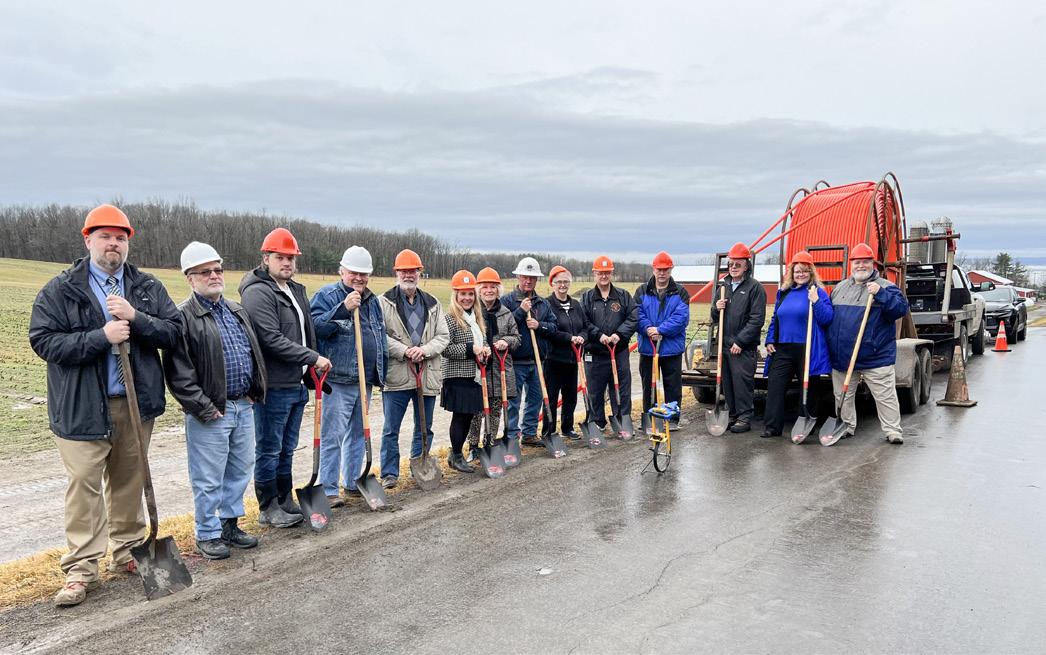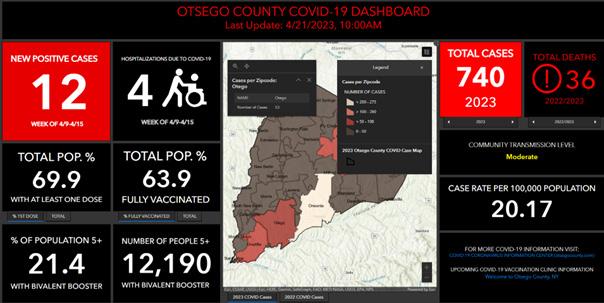NYSAC News
SUMMER 2023
Technology in County Government
 NEW YORK STATE ASSOCIATION OF COUNTIES
NEW YORK STATE ASSOCIATION OF COUNTIES

 NEW YORK STATE ASSOCIATION OF COUNTIES
NEW YORK STATE ASSOCIATION OF COUNTIES
PERMA is the trusted source to more than 600 public entities across New York State for not only strategic Workers’ Compensation coverage plans but also proactive and comprehensive workplace solutions.
Let PERMA be your source for:
better safety and risk management personalized service and support solutions for today’s workplace needs
Membership in PERMA includes access to valuable training programs, services and benefits that elsewhere are additional expenses.
Member Spotlight: STEUBEN COUNTY
“We were with a third party administrator that didn’t provide much support or solutions and were actively looking to change. PERMA understands the pressures of local government and was creative in finding a solution that worked for us as a self-insured pool.”
 – Jack Wheeler, County Manager & PERMA Board Member
– Jack Wheeler, County Manager & PERMA Board Member
PERMA’s diligent review of Steuben County’s prior Workers’ Compensation claims resulted in recovering for the county $400,000 in overpayments. They have been a PERMA member now for more than 9 years. Learn
Mental Health First Aid is a valuable resource that can make a difference in the lives of the one in four Americans struggling with mental illnesses and addictions, including those experiencing suicidal thinking. This eight hour in-person training teaches people how to help people developing a mental illness or experiencing a crisis.
Individuals trained in Mental Health First Aid can help:


Break down the bias against people living with mental illnesses, addictions and suicidal thinking.
Reach out to those who suffer in silence, reluctant to seek help.

Let individuals struggling with mental illnesses and addictions know that support is available in their community.
Who can be a Mental Health First Aider?
Law enforcement
Corrections officers
Other first responders
911 Dispatch Staff
Human resources professionals

Nurses and other primary care workers
School and college workers
What a Mental Health First Aider can do:
Defuse crisis
Promote mental health literacy
Combat the stigma of mental illness
Enable early intervention with recognition of signs and symptoms
Faith community leaders
Caring citizens
Connect people to care This training has been sponsored by: Montgomery County, NYS Conference of Local Mental Hygiene Directors (CLMHD) and the Staff of NYSAC!



For more information on these crucial trainings, call or email Sara Boerenko: 518-853-3531 or sboerenko@co.montgomery.ny.us



Michael E. Zurlo Clinton County President
Hon. Daniel P. McCoy Albany County President-Elect
Hon. Benjamin Boykin II
Westchester County
First Vice President
Hon. Philip R. Church Oswego County
Second Vice President
Hon. Martha C. Sauerbrey Tioga County
Immediate Past President

Hon. Luis A. Alvarez, Sullivan County

Hon. Steven Bellone, Suffolk County
Mr. Christopher Ellis Jr. New York City
Mr. Richard R. House, Wayne County
Hon. Beth A. Hunt, Hamilton County
Hon. Margaret M. Kennedy, Otsego County
Hon. Steven M. Neuhaus, Orange County
Dr. Kevin Watkins, Cattaraugus County
Hon. PJ Wendel, Chautauqua County
Hon. Herman Geist, Esq., Westchester County
Hon. A. Douglas Berwanger, Wyoming County
Welcome to our Spring/Summer edition of NYSAC’s official news publication. This issue is devoted to technology, an increasingly omnipresent aspect of our personal and professional lives. We are constantly and consistently connected to each other, our work, and the Internet.
All these connections provide us with instant information, greater efficiency, expanded capabilities, and increasing vulnerability, as we know firsthand from counties who have experienced cyberattacks. And with Artificial Intelligence (AI) becoming part of society, we have much to stay on top of as this area of technology is rapidly changing. I would like to commend the National Association of Counties for assembling a task force to address the impact of AI on county government operations and thank our own Association Director, Steve Acquario, for agreeing to serve on this important NACo Task Force.
This magazine incorporates articles that address numerous challenges and opportunities facing counties, as they deploy modern technologies to improve processes, productively and efficiently serve residents, and connect with systems at other levels of government.
I want to take this opportunity to give a big shout-out to our county IT Directors, Chief Information Officers (CIOs), Chief Information Security Officers (CISOs) and CIOs, and IT staff members for their work and dedication. These individuals kept our governments working around the clock through the COVID-19 pandemic. They work to protect us from various threat actors, along with keeping our systems up and running for when we need them. Thank you!
Considering this is the middle of June, I would be remiss not to comment on the State Budget, and the Legislative Session that is coming to a close.
This year’s State Budget proves, once again, the State’s addiction to using local funds—local property and sales tax receipts—to pay for State programs and services. Ironically, the theme for these recent State Budget negotiations was affordability. From a local perspective, however, the State merely takes local government resources, which in turn increases costs for our residents. To then make a claim that the State is more affordable couldn’t be further from the truth.
This year’s $230 billion State Budget (which equates to about $710 per person in the US), took even more money from local taxpayers to fund state programs. The Governor and State Budget Director justified these actions, by referencing the significant savings the state has supplied counties in the Medicaid program over recent years, by capping the local cost of the Medicaid program at $7.6 billion (about $23 per person in the US) a year. They are, however, ignoring the fact that counties have sent $132 billion (about $410 per person in the US) to Albany to pay for Medicaid since 2005. This is an enormous burden on county taxpayers— one that is not accounted for in the state’s financial plan. This Executive Action was unnecessary, especially with a State surplus.
As we have since the beginning of our association in 1925, NYSAC will continue to advocate for counties, our residents, and local taxpayers. As county leaders, we stand united in our effort to continue making our communities wonderful places to live and work, and sometimes that means standing up to our leaders in Albany. And we will continue to do just that.



(partial listing)
Stephen J. Acquario, Esq. Executive Director

Karen Catalfamo Office/Financial Manager
Patrick Cummings, Esq. Counsel
Jackie Dederick-Sylvain Records Manager
Nayeka Edmond Intern
Patricia Gettings Assistant to the Director
Ryan Gregoire Legislative Director
Alexandra LaMonte Legislative/Policy Coordinator
Mark LaVigne Deputy Director
Dave Lucas Director of Finance & Intergovernmental Affairs
Juanita Munguia Business Development Manager
Tom Oldfather Communications Manager
Kate Pierce-Nimz Multimedia Specialist
Jeanette Stanziano Director of Education & Training
One of the enduring challenges of communicating what county governments do is the fact that the services we provide often fall into that category of things that people take for granted and only notice when there’s a problem.
We pave roads, build parks, collect taxes, maintain property records, keep the peace, promote economic development, and care for those who need help.
At our best, counties help define what remains of the common good.
Unfortunately, as of this writing, counties across the nation are facing a myriad of new challenges, including political dysfunction around the debt crisis, mass shootings, and a migration crisis that has expanded from the southern border to the state of New York, further burdening our already strained public service agencies.
Simultaneously, unprecedented and accelerating technological change is also making the work of county government more challenging. Twitter, the hyperinfluential social media company has been making head-spinning changes to its platform. Until recently, Twitter has been an effective tool for people to keep track of tornado watches, train delays, news alerts or the latest crime warnings from their local police department. The removal of verification indicators are leaving legitimate public agencies and other organizations around the world scrambling to figure out a way to show we are trustworthy and providing accurate and usable information.
Governments at all levels—including New York’s counties—are banning TikTok, for its connections to foreign governments and its opaque algorithm that has the potential to serve, or repress, content of that government’s choosing.
We are also poised on the cusp of a technological revolution that brings even more uncertainty to our lives. I’m speaking, of course, of artificial intelligence or augmented intelligence.
So, what can we do as county leaders and members of the Association of Counties to address the changes and challenges we face?
We can do what we have always done. We can be stewards of the common good. Seeking out and sharing credible, usable, and timely information with the public and to our membership. We can explore and implement technology systems that improve the business of government in ways that help us deliver public services and conduct our daily operations. We can share lessons learned and best practices to educate our colleagues. We can support our public employees who may feel demoralized by the challenges facing governmental entities.
As county officials, we are all in this together. We continue to stand united in the face of the challenges that are upon us, and your association is committed to providing information and resources that can help you address them.
Stephen J. Acquario, Esq. NYSAC Executive DirectorNYSAC’s mission is to foster excellence in county government and unite the voice of New York’s county leaders.

President
Michael E. Zurlo
Publisher
Stephen J. Acquario
Managing Editor
Mark F. LaVigne
Editor
Tom Oldfather
Designer
Kate Pierce-Nimz
Advertising Staff
Juanita Munguia
its five boroughs for over 90 years. NYSAC’s mission is to foster excellence in county government and unite the voice of New York’s county leaders.
NYSAC
Send submissions to toldfather@nysac.org. Submissions should be 750 to 1,000 words and include a high resolution photo of the author. All submissions are subject to editing for clarity, content and/or length.
The advertisements and articles in NYSAC News in no way imply support or endorsement by NYSAC for any of the products, services or messages conveyed herein.
©2023 New York State Association of Counties


Since the 1960’s, the State of New York has relied on local tax revenues as a piggy bank to fund programs and services. Driven by a mixture of reluctance to cut spending or raise revenue, Governors and State Legislators of both parties have engaged in a sleight of hand that pushes the cost of state programs on to county governments.
Despite relying on this source of public funding year after year, the money commandeered from local taxpayers is not reported to the public nor accounted for in the State’s financial plan.
This year’s $230 billion State Budget – ironically themed around the promise of improving affordability in New York – doubled down on the State’s addiction to using local property and sales tax receipts to pay for State programs and services.
From a local perspective, however, the State simply takes local government resources, increasing local costs.
The Governor and State Budget Director justified these actions by referencing the significant savings the state has provided counties in the Medicaid program over recent years by capping the local cost of the Medicaid program at $7.6 billion a year.
While counties appreciate that without this cap, property taxes would be about twice as high as they are today, that $7.6 billion figure still earns New York’s 57 counties and New York City the unenviable distinction paying more for direct Medicaid program costs than the remaining 3000+ counties in the country combined.
This brings us back to the piggy bank. While state officials highlight the savings their Medicaid cap has provided, they ignore the fact that counties have still sent $132 billion to Albany to pay for Medicaid since 2005. This is an enormous burden on county taxpayers and one that is not accounted for in the state’s financial plan. So, for state leaders focused on affordability, it’s like this $132 billion fiscal burden on local taxpayers doesn’t even exist.
A key point State leaders need to remember about housing affordability is that the largest portion of most mortgage payments is property taxes, especially with two out of three mortgages today having an interest rate below four percent.
As time goes on, the property tax costs in that mortgage payment will grow proportionately larger as the mortgage payment is fixed, but property taxes, or assessments generally rise each year.
Medicaid is not the only program that State officials rely on county taxpayers to fund. When you add three other programs - Safety Net, preschool special education, and indigent defense – the county contribution to the State bottom line comes to a whopping $172 billion since 2005.
Defense $6,881,781,303
Total County
Share Paid for State Programs
$172,042,951,058
In SFY 2024, the counties and New York City will provide more than $12 billion in local tax revenues in support of the State Budget from seven major State controlled and designed programs, along with new cost increases for counties in the adopted budget and from last year’s budget.
For Medicaid costs, counties and New York City send weekly payments to the state to pay the State’s health care bills. For most other programs counties and NYC pay 100 percent of the costs up front and then apply for reimbursement from the State for its designated share (this is what we see in the State Budget – the State expense, not the local contribution) – these reimbursements can take well over a year to reach local bank accounts.
Comparing ourselves to other states is crucial as we compete against other states for economic resources, for jobs, for a high quality of life and an affordable lifestyle. These things are necessary to entice businesses and people to come to New York.
No other state in the nation requires county taxpayers to fund these four tate-level programs to such an excessive degree.
Comparisons matter because other states are increasing their population faster, growing jobs and business investment, increasing economic opportunity and producing a higher quality of life that is often more affordable than New York.
• Across the nation, most counties do not have mandated Medicaid contribution requirements. As mentioned, the counties of New York are required to pay more than all of the counties in the country combined for general Medicaid program costs.
• Only 22 states have such programs.
• In states that have these programs, costs are generally covered by the state.
• NYS is the only state in the nation that provides general assistance for disabled, unemployable, and employable people.
• NYS is one of only 16 states that have no time limit on general state assistance.
• NYS has the 6th highest state cash assistance amount.
• NYS is one of only a few states that require their counties to pay the majority of the costs (71 percent) of the state general assistance program (NYS pays 29 percent).
◊ Emergency shelter has become a major expense for counties, as shelter rates supported with state funds have not been updated in nearly 20 years while housing costs have soared.
• The federal government defines the Early Intervention (Part C) and Preschool Special Education (Part B) programs as education programs under the IDEA.
• New York requires counties to pay 40 percent of the cost of these programs.
• As a result, most counties do not pay a share of these costs as it is a function of the school district.
• Only 20 states require their counties to pay a share of indigent defense costs.
◊ Overall, 35 states pay the vast majority of the costs, not counties.
• Since 2007, New York counties have paid on average about 79 percent of these costs each year.
◊ The Hurrell-Haring settlement has shifted these shares a bit as the State increased its financial support – in 2023 the county share was about 65 percent.
The county resources the State uses to pay for their programs are not visible in the state budget, or accounted for in the State’s financial plan, but would comprise an important share of the State’s general fund if identified. By excluding these funds from public view and discourse, State leaders disregard how these local costs impact the overall affordability issue facing New Yorkers.
This NYSAC analysis covers only four State-level programs. There are dozens of other programs that require extensive county contributions to support State programs. These include, but are not limited to, child welfare, foster care, early intervention, probation, and public health, along with laws and regulations in the areas of environment, energy, procurement, construction, and insurance. All these costs contribute to affordability yet are not included in the annual state budget process or recognized by State leaders as part of the affordability problem facing New Yorkers.
The State cannot continue sweeping $12 billion a year from local taxpayers and pretend like it doesn’t exist. If State and local government leaders want to address affordability, then we must have better transparency, and a larger discussion must take place about how we pay for State programs.









NYPA can help your town chart its clean energy path. We take into account your need to balance cost, sustainability and community goals – for the clean energy solution that fits your town best.


Our experts bring proven audit, planning, procurement and implementation solutions – together with unparalleled knowledge of New York State regulations and incentives. Talk with us about how we can help streamline the bidding process with preapproved developers to save you time and money.

Let our project managers and engineers serve as an extension of your team.

Learn more about all our clean energy offerings. Consider exploring the best options with us!
To learn more, provide your information at nypa.gov/services123 EnergySolutions@nypa.gov



Building on a legacy of environmental stewardship and climate action, the State Fiscal Year 2024 Enacted Budget includes appropriations and legislation that will bring New York State closer to reaching the goals established by the nation-leading Climate Leadership and Community Protection Act (“Climate Act”).
Signed into law in 2019, the Climate Act set incremental goals of achieving 70 percent renewable energy by 2030; 100 percent zero-emission electricity by 2040; a 40 percent reduction in statewide greenhouse gas emissions from 1990 levels by 2030; an 85 percent reduction from 1990 levels by 2050; and net-zero emissions statewide by 2050. It also called for the issuance of a Scoping Plan with recommendations for charting a path toward carbon neutrality while ensuring equity, system reliability, and a transition from a fossil fuel economy to a clean energy economy. This year’s state budget adopts many of the Scoping Plan’s recommendations and lays the groundwork for achieving its goals.
The budget prohibits the use of fossil fuel equipment and building systems in new construction, beginning on December 31, 2025, for buildings under eight stories and beginning on December 31, 2027, for all new buildings. This prohibition will not affect the installation or continued use of fossil fuels in existing buildings. The budget also allows for various exemptions, including for emergency back-up power, medical facilities, critical infrastructure, and new buildings for which new or expanded electric service cannot be provided by the grid.
The budget authorizes the New York Power Authority (NYPA) to build renewable energy projects and sell the energy to any public entity, community choice aggregation (CCA) community, and other customers. It also requires NYPA to publish a Renewable Energy Generation Strategic plan, that includes ways to minimize any negative tax revenue impacts on municipalities that host renewable energy projects. The legislation does not require municipalities to obtain their electricity from NYPA.
The budget directs NYPA to establish the Renewable Energy Access and Community Help (REACH) Program, to provide low- or moderate-income New Yorkers in disadvantaged communities with electricity bill credits generated by the production of renewable energy from NYPA projects. It also includes $200 million for the EmPower Plus program, to help 20,000 low-income families retrofit their homes by adding insulation, installing energy efficient appliances, and switching from inefficient fossil fuel heating systems to electric alternatives.
The budget creates spending guidelines for a “cap and invest” program that will set an annual, declining limit on emissions. It stipulates that revenue from the auction of emissions allowances will be deposited into a Climate Action Fund, to offset cost increases for individuals and industrial small businesses and help the state in transitioning to a less carbon intensive economy. The Department of Environmental Conservation (DEC) is expected to issue draft regulations this summer detailing how the program, which is expected to go into effect in 2025, will work.
The budget directs the Department of Labor (DOL) to develop a comprehensive plan to transition, train, or retrain employees that are affected by climate risk-related and energy transition projects. It also requires DOL to create a program to offer newly created job opportunities to transitioning workers who have or will lose their employment in the energy sector. A new Office of Just Transition within DOL will support both conventional energy workers and communities burdened by fossil fuel infrastructure as they navigate the transition to a clean energy economy.
There are also several recommendations from the Scoping Plan that did not make it into the final budget, including legislation to shift responsibility for the recovery of materials in curbside recycling programs from local governments and taxpayers to producers and brand owners. State lawmakers are expected to work toward achieving an agreement on this and other environmental priorities before the end of the 2023 Legislative Session.
 By Courtney David, Executive Director, NYS Conference of Local Mental Hygiene Directors
By Courtney David, Executive Director, NYS Conference of Local Mental Hygiene Directors

The Drug Enforcement Administration (DEA) recently proposed regulatory amendments to help offset the impact of the Ryan Haight Online Pharmacy Consumer Protection Act of 2008 upon the expiration of the COVID-19 Public Health Emergency on May 11th.
The 2008 statute prohibits the distributing, dispensing or delivery of controlled substances via the internet without a valid prescription. It applies only in limited circumstances where the practitioner wishes to prescribe a controlled substance via telehealth and has never conducted an in-person medical exam of the patient. In the years since it was enacted, the DEA has used the Ryan Haight Act to regulate the controlled substances market to deter unethical and substandard prescribing practices.
During the pandemic, the DEA relaxed certain requirements to ensure patients could continue to receive life-saving medications via telehealth while minimizing exposure and preserving provider capacity. Flexibilities like waiving the required initial in-person visit prior to prescribing controlled substances via telehealth and allowing the use of telephone evaluations to initiate buprenorphine prescriptions have proved critical in supporting patients. These waivers have improved access to care for patients with substance use disorders and serious mental illness in areas where shortages of prescribers existed prior to the pandemic.
The DEA’s proposed regulatory amendments would require an in-person medical evaluation prior to prescribing a controlled substance. While we recognize the DEA’s proposed rules are an attempt to ensure that patients do not experience lapses in care, they miss the mark on service needs post-pandemic. If approved, these regulations will significantly disrupt current service delivery in many counties in New York.
Severe shortages in the mental health workforce, compounded by the extreme difficulty of attracting authorized psychiatric prescribers in certain parts of the state, create an almost impossible task of providing quality treatment to people suffering from serious mental illness and other behavioral health issues.
The NYS Conference of Local Mental Hygiene Directors, which represents the Directors of Community Services (DCS)/county departments of mental health in New York State, submitted comments to the DEA highlighting the problems that these proposals will cause. In our comments, we acknowledge that the Ryan Haight Act was intended to address the threat to public health and safety caused by physicians who prescribed controlled medications via the internet irresponsibly. However, circumstances have changed in the 15 years since the passage of this law.
Many counties in New York have been able to establish successful treatment programs during the COVID public health emergency based on these flexibilities. One county has solved the difficult issue of finding a child psychiatrist to prescribe necessary stimulants by employing a retired psychiatrist who had relocated to the south but is continuing to work remotely. While successful, this situation may no longer be permitted under the proposed rule, thus leaving the county without any coverage for these children or with the need to refer them to primary care providers, who often lack the specialized knowledge to provide the same quality of care.
In at least three other counties, all controlled substance prescribing is currently being accomplished through telehealth. One county, which has over 1,100 square miles (about half the area of Delaware) of territory, had no provider/prescriber for at least nine months in 2022. Prior to that, it was found that the previous prescribers were not culturally competent and did not understand the local population or what resources were available.

Furthermore, referral to primary care, although supportive, did not work because in many cases primary care doctors do not understand psychiatry and often overprescribe medication, use medication that is contra-indicated, or do not provide the appropriate follow-up in terms of lab work and health monitoring. Using primary care providers also makes coordinating therapy appointments and appropriate therapeutic interventions difficult.
This county has essentially solved all of these problems by hiring a telehealth psychiatrist who they feel is completely committed to their population and with whom they are most satisfied. Implementation of the DEA’s proposed regulation would make this solution illegal.
Another county, which does not have a hospital or psychiatric service within its boundary, has found it very difficult to attract in-person psychiatric services, especially considering the significant workforce issues now facing the field. The county used telehealth companies throughout the COVID emergency that specialize in providing psychiatrists and/or Nurse Practitioners in psychiatry for remote prescribing, and they are getting a higher caliber of provider. If the proposed regulations are implemented, no in-person provider will be available to provide psychiatric medications and this county clinic would not be able to prescribe Medication Assisted Treatment.
After receiving more than 38,000 comments to the proposal, the DEA and the Department of Health and Human Services recently submitted a draft temporary rule to the Office of Management and Budget so that the telehealth flexibilities for controlled substances could continue. We are pleased that more consideration is being given prior to approval of these regulations to allow for the continuation of telehealth prescribing in essentially the same manner as has been successfully utilized during the PHE.
 By Paul Brady, Executive Director of the New York Public Welfare Association
By Paul Brady, Executive Director of the New York Public Welfare Association
While the term ‘unwinding’ conjures up images of a watch mechanism or a tangled ball of yarn, for our purposes the term applies to the Medicaid program and carries significant implications for State and Local Government operations over the next fourteen months.
During the COVID-19 public health crisis, federal law prioritized continuous Medicaid coverage and prohibited more restrictive eligibility criteria. As a result, Medicaid cases that would have needed eligibility re-determined, were granted continuous eligibility for the crisis.
Medicaid’s continuous coverage provision ended in December 2022 with the passage of the Consolidated Appropriations Act of 2023. While the Act did not end the Public Health Emergency (PHE), it did end the continuous coverage requirement. (Note: The PHE is set to end on May 11, 2023.)
Termination of the continuous coverage provision now means that both the state and local Departments of Social Services (LDSS) must now go back and redetermine eligibility for all these cases. This is a formidable task. To put this in perspective, at the beginning of the PHE in March 2020, there were 7.3 million enrollees in Medicaid, Essential Plan and Child Health Plus. By the end of 2022, that number had grown to 9.2 million. Medicaid alone accounted for 1.6 million enrollees.
The eligibility re-determinations will affect approximately 8 million New Yorkers. The work will be split between the State through the New York State of Health Portal, responsible for 5.3 million members (about twice the population of Arkansas) and LDSS, which will process redeterminations for 2.4 million members (about the population of Kansas).
Per guidance from the federal government, no more than 1/9th of the total caseload can be redetermined in any given month and the state is encouraged to spread the redetermination process over the entire unwinding period. Renewal packets
went out to recipients in New York City in March, and in April for the rest of the state. The state sends out their notices in May.
End dates for Medicaid coverage in the first wave of the unwinding would begin on June 30th, and for new Medicaid applications filed in July, normal rules of eligibility would apply.
During continuous coverage, a great deal of change can occur in recipients' lives. Most notably if they were to move, a renewal packet that gets mailed out as part of the redetermination process may not make it to the intended recipient. If that were the case, the recipient could potentially lose coverage.
Therefore, the State Health Department has already launched a public relations campaign to advise recipients that if they have changed their address, they need to make sure that information is known so a redetermination packet can be sent to the correct address. Also, as redetermination packets are returned as undeliverable, additional efforts must be taken to find the recipients before any adverse action can be taken on the case.
For an LDSS, this work comes at a time when many offices are facing significant staff shortages. The pandemic has affected everyone’s workforce and local social service agencies were not immune from the waves of departures. The recruiting, hiring, and training of workers has proved difficult, and staff shortages have a direct impact on the volume of work that can be processed at the county level.
The situation is further worsened by the redeployment of existing staff from areas like Medicaid, to process new and existing redeterminations for Supplemental Nutrition Assistance Program (SNAP) cases.
Local district staff are committed to completing the task and ensuring no one unnecessarily loses their Medicaid coverage, but it is critical that districts have the tools and resources needed to complete the unwinding successfully.


Trusted and highly recommended for over 38 Years to provide Surplus Property & Real Property Auction Services with proven results




"they

“Randy and the Collar City team take care of ever-thing… they really do it all…proven experts in the business” “I highly recommend Collar City to anyone looking to simplify the auction process and lighten your workload”

–Matthew Ossenfort, Montgomery County Executive
"highly
“Randy and his team are courteous, highly qualified, experienced and knowledgeable in all aspects… a team proven to be specialists in the business”
–Mark Wojcik, Rensselaer County CFO
"During the preparation, planning, and process of conducting the Auction, we found the Collar City Auctions Team to be professional, courteous, and attentive to our needs and requirements."



 -Kevin Gardner, Oswego County Treasurer
-Kevin Gardner, Oswego County Treasurer

Governor Kathy Hochul announced on February 22, 2022, the creation of a new Joint Security Operations Center (JSOC) in Brooklyn to serve as the nerve center for joint local, state, and federal cyber efforts, including data collection, information sharing and response. This venture represented a first-of-its-kind initiative to develop a cyber command center that would provide a true statewide view of the overall cyber threat landscape and improve coordination on threat intelligence and incident response.
Given this new charge from the Governor, work began immediately to turn vision to reality. During the following few months, multiple teams collaborated to develop new systems and associated processes which culminated in the official launch of the New York State Security Operations Center (NYSOC) on September 29, 2022.

The technology powering NYSOC has been carefully selected through a process which evaluated various tools across multiple criteria such as overall functionality, ease of use and management, adherence to a zero-trust security model, and ability to scale up in performance and capacity to the needs of a true statewide solution. The core functions of NYSOC are powered by a robust Security Incident and Event Management (SIEM) platform which receives log data from subscribers.
The SIEM then reviews logs in real-time to identify security concerns which in turn generate incident management system “tickets” for analyst review and notification to the subscriber for further action.
NYSOC supports multiple threat intelligence feeds that provide the most up-to-date information available, and the inclusion of artificial intelligence and machine learning (AI/ML) to help ensure these alerts are accurate and actionable rather than noisy false positives. The NYS Office of Information Technology Services (ITS) officially became the first subscriber of NYSOC April 24, 2023, and as a result receives the benefit of cyber analysts watching alerts 24/7/365.
While there has been tremendous progress to date, as with many cybersecurity initiatives, the work is never truly done. As the NYSOC moves into its next stages, the focus is now to build upon and improve its capabilities.
Over the coming months, the team will continue to develop and implement new use cases that will trigger alerts. Typical use cases currently include traffic to malicious sites, repeated failed access attempts on a server, unexpected uploads of large amounts of data, and similar suspicious behavior. Use cases will also be implemented that focus on new and emerging threats as they are discovered, such as activity that aligns with attempts to exploit recently announced vulnerabilities.
In addition to the technology stack being developed, NYSOC also plays a key role in the new “shared services” offerings available from the state. The deployment of free CrowdStrike Falcon Endpoint Detection and Response (EDR) software was the first offering and has been a tremendous success in enhancing the overall security posture of counties. The next offering is slated to be Attack Surface Management (ASM), which will provide NYSOC subscribers with a comprehensive view across all current risks and vulnerabilities in the environment. By combining the data received through the EDR, ASM, and SIEM log sources, the NYSOC will have insight into the cybersecurity posture in a whole-of-state manner that was never previously available. This will allow the NYSOC to draw comparisons across multiple alerts and subscribers, providing a source of custom threat intelligence that will be shared back to subscribers to better improve our collective defenses against an ever-increasing threat landscape. This level of data will also be crucial in determining what future shared services can be developed that will result in a more mature cybersecurity posture across the state.
While ITS is the first customer, NYSOC has already started the process of onboarding additional subscribers. The cities of Rochester, Buffalo, Syracuse, Yonkers, and Albany are slated to be the next subscribers to the NYSOC. A sign-up portal for new subscribers will launch in the coming months and will be offered to all New York counties. If you have questions about the overall NYSOC mission or how to get involved, please reach out to the DHSES Cyber Incident Response Team or the ITS Chief Information Security Office for more information cirt@dhses.ny.gov or ciso@its.ny.gov.
This year’s theme of Counties in Action sought to highlight the people providing and receiving local services throughout NYS Counties.

Counties provide hundreds of services, which often go unseen. We decided to shine a light through photography in celebration of County Government Month.

Be sure to look for these photos in the 2023 NYSAC "Counties in Focus" Calendar!
International Overdose Awareness Day

50th Anniversary of Vietnam War
Orange County
Photographer: Justin Rodriguez
Broadband Project Groundbreaking

Erie County
Yates County
DPW Headed to WNY

Fish Stocking at Sacandaga

Albany County
Saratoga County
Photographer: Kara Kane Photographer: Brandon Lawson Photographer: Mary Rozak Photographer: Christine Rush




At the 2021 Fall Seminar, we approached leadership at the New York State Association of Counties with a simple idea: to create a technology group within NYSAC. Similar in form to the standing committees, this group would aim to address issues that affect information technology departments in counties across the state. Most importantly, it could alert nontechnical county leaders of a variety of critical technology issues.
Later that year, the NYSAC Board of Directors created the NYSAC IT Task Force to serve as an advisory group for major information technology (IT) and data issues that impact the operations and governance of counties across the state. Cybersecurity preparedness, procurement, state deployment of modern technology systems, related county activities, and state legislatives, to name a few, are some of the key issues that the group aims to address.
The mission of the IT Taskforce is to work cooperatively to provide advice, strategic direction, collaboration, and insights for the safe, secure, and effective use of information technology in counties (and all governments) across New York State.
Our vision is simple, we are looking to share the best practices, challenges, and solutions—along with ways that counties can become the standard in a safe, secure, and effective way; using information technology through a collaborative leadership, policy, and technology—approach.
Since technology touches virtually every business process in county government, the Task Force is designed to include members from across the spectrum of county departments. Yes, we have county IT Directors, but we also include elected county board members and county clerks, and we would like to add county election commissioners, emergency services officials, social service directors, planners, procurement officials, along with others that play key roles, in the use and deployment of technology in their departments.
Over the two years that the Task Force has been in existence, we have met at NYSAC Conferences and virtually. We have heard from a variety of speakers and held discussions about the challenges and opportunities facing counties in technology and cybersecurity, as well as the transition to a new statewide social services program, a new security focused procurement organization, IT staffing, and other topics.
We will continue to discuss the critical technology issues facing county departments, promote the effective and efficient integration of technology, and develop a collaborative pipeline for best practices in shared services, integrations, and cybersecurity.
For those interested in joining the IT Task Force, please contact NYSAC Deputy Director Mark LaVigne at mlavigne@nysac.org.

 By Rita Reynolds, CIO, National Association of Counties
By Rita Reynolds, CIO, National Association of Counties

In early 2020, the National Association of Counties officially created the NACo Tech Xchange, a network designed to bring together county IT Leaders and staff to engage in idea sharing, problem solving and discussions around technology. This network has now grown to over 1,000 IT professionals and not only helps counties, but it also provides NACo with feedback and input for national discussions and representation. The network along with the NACo County Technology Advisory Council and the IT Standing Committee also assist in the development of annual technology priorities. The 2023 Technology Priorities are readily available and can be used to educate elected officials as well as other stakeholders that have an interest in supporting local government.
Cybersecurity will continue to be at the top of county technology leader concerns. To that end NACo worked with Accenture to produce a recently completed resiliency report. The study included focus group meetings, individual county IT leader interviews as well as a survey. In the report you will find survey results, including the statistic where 40 percent of counties report that the number of attempted, unsuccessful breaches has increased over the prior year. Areas of concern will continue to be budget as well as retaining cyber insurance. The publication concludes with recommended actions including conducting assessments, developing a strategy
focused on workforce and taking advantage of partnerships. Other valuable resources available at NACo.org include the NACo cyber priorities and a cyber guide for county leaders.
Workforce shortages continue to be a challenge overall for IT, not just with cybersecurity. While competitive salaries are an issue, county IT is finding some success with focusing on the benefits, such as long-term employment. NACo provides several career development opportunities for county IT leadership including the High Performance Leadership Academy course on Cybersecurity Leadership.
With the ever-growing volume of county electronic documents and records, data governance is becoming an even greater challenge. You can only protect what you are aware of. And with the increased security requirements from auditors and cyber insurance providers, counties are focused on ensuring they have a data asset inventory and have applied the proper security controls. To assist in this area, NACo provides access to a member only portal which contains templates for policies, job descriptions and toolkits, including asset inventory templates.
Broadband connectivity remains a top priority for counties with unserved and underserved residents. A plethora of federal funding has super-charged the broadband infrastructure deployment landscape, and county IT leaders are tasked with ensuring the strategic deployment of high-speed internet that will adequately provide high-speed internet to every county resident in need. County IT leaders can help strategize for deployment projects through innovative GIS mapping and data-sharing with the state broadband office; by fostering a local focus for ensuring internet service providers are offering accessible and affordable internet services; and by serving as an educator and leader for promoting adoption to the network, fostering digital skills for residents in need, and providing resources to encourage participation in the benefits and services of the internet.
As stated in the NACo/Accenture publication (mentioned earlier), 63% of counties are utilizing a mixture of cloud and on-premises infrastructure to host their applications and technology operations. Due to staffing shortages as well as greater security measures through utilization of the cloud, counties will push even more functions to the cloud. NACo’s focus will continue to assist counties in providing guidance in areas such as contract language. This includes a TechBrief on contract language, which is available to NACo Tech Xchange members.
According to the U.S. Census Bureau, approximately 72 percent of all counties in the United States are considered rural, and about 76 percent have a population of 50,000 or less. Consequently, it is difficult for many of the counties in this category to keep pace with the growing need of sufficient cyber protections, let alone move towards modernization of their systems and provide more digital services for their residents. For 2023 NACo is facilitating several pilots with corporate partners that are focused on bringing no code/low code and security services to this county segment. For more information you can reach out to Kimberly Ransom, NACo Technology Networks Program Manager at kransom@naco.org .
As one can imagine, autonomous innovation is growing by leaps and bounds. Counties are working to improve their posture when it comes to the use of autonomous equipment, including drones, self-driving equipment (tractors, lawn mowers), and robotics. In order to facilitate discussions, NACo focuses at least one segment of the in-person CIO Forums that occur at NACo’s conferences. For the July 2023 CIO Forum, there will be presentations and demonstrations of autonomous options and relevant use cases for counties in areas such as facilities, GIS, etc.
Upgrading phone systems, eliminating legacy systems, mobilizing workforce, modernizing systems in business areas (like human services), and utilizing AI (artificial intelligence) —modernizing legacy systems is not easy. However, it is necessary, especially in the wake of security vulnerabilities that legacy systems cannot avoid as well as retirements of the workforce that has maintained them. NACo’s efforts here focus on awareness of options and services available to assist counties in this area. NACo Technology Corporate Partners play a significant role in this area and often will provide no cost or low-cost assistance. A good example of this is a just completed low-code/no-code pilot with 10+ counties.
IT STRATEGY AND ROADMAP: Also, a new priority for 2023, county IT leaders asked for education on IT strategy alternatives. To that end, NACo has started a series of TechKnow Webinars. These monthly one-hour sessions are county CIO or IT Director led and focus on sharing tips, techniques and lessons learned. The most recent webinar covered conducting an IT assessment and developing a roadmap for improvement.
Emerging amid these top ten are two areas of intense focus, the TikTok situation and Generative AI. Earlier in the year, NACo surveyed the county IT landscape and provided insight on how counties were responding to the TikTok situation. Due to the volume of state and county bans being applied, tracking this situation will continue to be an emerging priority. However, the spotlight has now turned to the emergence of generative AI. Truly this is an innovation that has taken the world by firestorm and is already demonstrating huge benefits for counties. As one county IT leader stated, “It gets you 70 percent of the way there, and you fill in the last 30 percent. It is definitely a productivity multiplier.”
While possessing a wealth of benefits, there are also risks and challenges that will need to be addressed as generative AI continues to evolve. NACo has issued a TechBrief on ChatGPT to its Tech Xchange members, and has also provided initial thoughts in a recent article. We will continue to evaluate the changing landscape and engage with county IT leaders to know how best to proceed in providing additional resources and representation for counties.
As one can see there is a tremendous amount of work taking place to support counties in their technological growth and strategy development. We will continue to provide resources, education, and guidance through the NACo Tech Xchange as well as to all NACo members throughout the year. For more information on these priorities, the NACo Tech Xchange or committee involvement, you can reach out to Rita Reynolds, NACo CIO at rreynolds@naco.org .
Registered Municipal Advisor Serving New York State Municipalities Since 1967

Bond & Note Issues w Refunding Bond Issues w Lease Financings w EFC Short and Long Term Financings w
Energy Performance Contract Financing w Credit Ra�ng Assistance w Accoun�ng & Bookkeeping Services w Cash Flow Borrowings w Con�nuing Secondary Market Disclosure
CORPORATE HEA DQUA RTERS
250 South Clinton Street, Suite 502, Syracuse, NY 13202 Phone (315) 752-0051
John Shehadi, CIPMA, Municipal Advisor
Mark Vislosky, CIPMA, Municipal Advisor
Christine Crowley, CIPMA, President/Municipal Advisor
Benjamin Maslona, CIPMA, Executive Vice President/Municipal Advisor
CAPITAL REGION
Jeanine Rodgers Caruso, CIPMA
MBA, Municipal Advisor 63 Putnam Street, Suite 202

Saratoga Springs, New York 12866 (518) 541-3861
HUDSON VALLEY REG ION
Beth Ferguson
Vice President/Municipal Advisor 827 Rte 82, Suite 10231
Hopewell Junction, New York 12533 (845)447-2214
www.fiscaladvisors.com

Founding firm member of the Na�onal Associa�on of Municipal Advisors
WESTERN REG ION
Kelly Lathan, Financial Analyst 5 North Avenue LeRoy, New York 14482 (585)502-5010


During the pandemic, county IT departments were heavily relied upon to ensure critical government operations continued despite widespread shutdowns. They set up thousands of staff in remote access work locations, facilitated virtual meetings, commissioned hundreds of new devices, spun-up new applications, designed and implemented new networks, and supported diverse health and pandemic-related functions. In short, they moved mountains, in a short time and many with limited staff.
Now with the pandemic over, county IT departments are moving ahead with projects that had been placed on hold, responding to new state regulations and infrastructure changes, keeping
the county secure, modernizing enterprise administrative systems, and continuing to support everyday operations for all county departments.
From the outside it looks seamless, but from the inside, county IT leaders know it is an integrated machine with many moving parts on different timelines with a range of stakeholders. With increased focus on how county IT departments lead and transform countywide operations and services this article sets forth ideas to three main questions: What are the core areas of responsibility for county IT departments? What are some realities facing IT leaders? And what might county and IT leaders do right now to address some of the realities?
IT Leadership Leading the digital transformation vision of the county. Titles in this role are typically Chief Information Officer (CIO) or Commissioner of Information Technology.
IT Management Managing all IT operations and services (this is different than leadership). Titles in this role are typically IT Director and IT Deputy Director.
Cybersecurity Leadership Defining and leading the county’s information security strategy. A typical title in this role is Chief Information Security Officer (CISO).
Cybersecurity Management and Activities
Designing, developing, and implementing cybersecurity activities in line with the county’s information security strategy. Titles include Cybersecurity Manager, IT Security Manager, Information Security Supervisor. Network Administration Overseeing network devices and managing infrastructure projects. Titles in this role are typically Network Administrator, Network Specialist, Network Engineer.
Telecommunications Maintaining electronic equipment with communication abilities and its infrastructure. Titles in this role are typically Telecommunications Specialist and Telecommunications Engineer. Application Development Developing and maintaining software applications, this includes adhering to a range of standards. Titles in this role are typically Application Developer, Software Developer, Platform Developer. System Administration Maintaining system operations and their continued functionality and performance while developing group policies. Titles in this role are typically System Administrator, IT System Administrator, IT Specialist. Helpdesk and Support Providing support and training to end-users for solving computer and system issues in a systematic manner. Titles in this role are typically Helpdesk Specialist, Support Specialist, Service Desk Specialist. Business Intelligence Analyzing and interpreting information and data to support decision-making and strategic management in various functional areas. Titles in this role are typically Business Intelligence Analyst, Business Analyst, Business Analytics Specialist.
Geographic Information Systems (GIS)
Developing and operating geospatial applications and analytics to support planning and other countywide functions. Titles in this role are typically GIS Specialist, GIS Analyst, GIS Officer. Project Management Planning, monitoring, controlling, and managing technology projects from initiation to transition to support. A typical title in this role is IT Project Manager. Website and Social Media Platforms
Developing and managing digital media platforms and outbound communication in line with the county’s engagement and communication strategy. Titles in this role are typically Web Site Designer, Social Media Specialist, Communications Specialist, Digital Communications Specialist.
Increasingly Complex County IT Environments Are Requiring Specialty in Each Responsibility Area.
As technology is evolving and county IT environments become more complex, there is a need for specialization within each responsibility area. While many large cities and counties throughout the U.S. have been able to equip their departments with dedicated staff in all areas of responsibility, most counties are not able to have distinct staff in each area due to limited resources. This means that people must carry out work in multiple areas and as the technical architecture grows into more complex structures, IT leaders must make difficult choices in time and attention.
The national shortage of IT talent for all sectors means counties have even more of a challenge. With salaries lower than industry and some governments, a set of requirementheavy civil service processes, and practices within some counties (little to no remote work options) there is a clear and distinct disadvantage for counties. This emphasizes the need for counties to review and, if possible, modernize human resources and work practices as well as streamline the hiring process to attract and retain IT talent. Such changes have to be socialized within the leadership as some leaders might not be aware of how limiting the current practices could be for their IT departments.
Increased Cyber Threats.
Protection of county assets is always on the mind of cybersecurity and IT leaders. Aging legacy systems in need of modernization, expanding county networks, and increasingly sophisticated threats from bad actors mean cybersecurity is at the center of every IT department. Although the cyber skills needed to protect the county are specialized and not the same as skills necessary to run IT operations, with an increase in the frequency and sophistication of attacks, IT leaders are taking time away from development and modernization and focusing on security out of necessity. It is a constant shuffle of priorities.
A county IT leader is first responsible for the IT and cybersecurity of the county operations and services, but many are being called upon to play a leading role in IT efforts for the county at-large. These efforts are more community-based, bringing together the private, nonprofit, and public sector for the good of the county. While these are important efforts and need county IT involvement, it adds another area of responsibility that typically falls to the CIO or IT Management team. Balancing the community facing efforts with the already long list of actions required to lead the county’s internal operations and services has become increasingly a challenge for county IT leaders.
If you haven’t already, schedule a set of candid conversations within the next two months between county leadership and IT leaders with the goal of building a shared understanding of how IT leads, supports, and protects the county’s business. If these already take place, schedule more. But remember, these are not project level discussions. These candid conversations are enterprise-wide discussions on how technology is used to innovate and create value. The following questions can prompt those discussions.
• What can county leadership learn from the IT department’s unique bird’s-eye-view of the entire county?
• What are the core functions we carry out across the county? Do we use the same hardware/software across the department or different ones? What does this mean for the IT department in supporting these departments? What should we plan for in the future as needs emerge?
• How many users does the IT department support and how is this similar or different to other counties?
• How is technology evolving (i.e on premise vs. cloud) and how is it changing what we do? What are the implications for the IT department?
• What technical NYS regulations and architectural changes are adding to the IT workload in our county?
• Of all the IT department responsibility areas, which ones are the most in need of resources?
• Why are data classification efforts so time-consuming? Has our county classified all our data? What are the implications of not carrying this out? What do we need to do to get this complete?
• What are the biggest challenges in recruiting and retaining IT talent in our county IT department?
Members of the NYS Local Government Information Technology Directors Association (NYSLGITDA) provided input to this article. NYSLGITDA an organization dedicated to the coordination and improvement of information technology to carry out public services in municipal, school, community college, BOCES, and authorities in New York State. www. nyslgitda.org
CTG UAlbany is a globally recognized and award-winning applied research center working alongside local, state, and federal government leaders to generate new knowledge and build capability.








Rapidly advancing technology is now being used to fill the gap created by staffing shortages and vacant positions in county government offices. While it’s true that adding the latest tech tools to county offices can help existing staff to work more smartly and efficiently, there are also some challenges to consider.
There are three major obstacles to consider before adding new technology to your county offices: (a) the cost of the hardware, software, and any installation charges since these are sometimes not included in the current operating budget; (b) implementation challenges compounded by IT staff shortages and workload bottlenecks; and (c) a lack of conclusive and definitive proof that the new technology will actually provide a worthwhile positive benefit to the county within a short period.
But what if there was an advanced technology that eased workloads and paid for itself almost immediately? Even better, what if that same technology actually brought in additional and previously-untapped revenues that could be used to pay for other county operating expenses and high-priority projects?
What if there were zero IT challenges because county staff had secure remote access from the county’s existing computer systems?
Finally, what if 27 other counties in New York State were already using this advanced financial technology with proven, measurable results that reduced staff workloads and brought in tens of millions of dollars of new, non-tax revenues every year?
Although all this may sound too good to be true, such a technology already exists and is proven. And it’s now available to every county in New York State thanks to an intermunicipal cooperative partnership that includes NYSAC and NACo.
One of the greatest developments in technology for counties over the past several years has been the widespread adoption of three+one’s cashVest® system of advanced cash management. By pairing the latest technology with advanced software algorithms that look at every single dollar of a county’s historical expenditures and revenues, accurate predictions of future cash flows and liquidity levels can be made with incredible precision. This eliminates potential funding shortages, reduces cashflow borrowings, and instills confidence regarding long-term finances. This patented technology also analyzes and compares all hard and “soft” banking fees and identifies any accounts or funds that are underperforming market conditions.

On average, cashVest finds an average of 73 percent more liquidity that can be put to work earning today’s high interest rates.
This liquidity data is then paired with an ever-expanding network of the most recent competitive interest rates being offered by banks on CDs, Treasuries, and other 100 percent secure, government-backed, fixed-term investments. What are the actual results of this advanced financial technology? More than $1 billion in new revenue has been deposited into municipal bank accounts over just the past five years! That means additional resources to help counties meet their other spending needs— as well as other technology needs—without raising taxes.
New technology can be daunting, expensive, and sometimes delivers inconsistent results. Because of those challenges, it’s understandable that municipal offices tend to want to keep doing things they way they always have, and let the new technology prove itself first. cashVest is an example of an advanced, proven technology that presents us with a better, more efficient, and more cost-effective way to serve the taxpayer.
When a tool comes along that eases staff workloads, quickly pays for itself (and more) through higher revenues, and has already proven itself to be an effective and efficient financial asset in hundreds of other public entities all across the country, then the time is right to give this advanced technology a closer look.
William Cherry is a Past-President of NYSAC, a past NACo Board member, and he served for 24 years as Schoharie County Treasurer. As a county CFO, he was responsible for managing and investing all public funds, and as Budget Officer, for finding ways to pay for new technology without increasing taxes. He now serves as the Director of Public Partnerships for three+one, and can be reached by phone at 585-484-0311, ext. 709 or by email at wec@threeplusone.us




The New York Power Authority (NYPA) is a leader in clean energy solutions for New York State. NYPA offers advisory services and implementation expertise in energy efficiency, DER (solar and storage), and EV infrastructure.
NYPA serves towns, cities, counties, and communities across the state; working as partners with local governments to build the best action plan, and to help implement clean energy initiatives.
The world of clean energy is constantly shifting, with new technologies and innovations guiding a path to New York State’s clean energy future. NYPA’s Research, Technology Development and Innovation team works with customers, governments, research organizations and universities to develop, implement, test, and evaluate the efficacy of new tools and techniques.
Our team actively seeks innovative solutions that will combat climate change, protect the environment, and improve the performance of the electric grid. Research projects also focus on helping New York State reach its nation-leading clean energy targets and advance the Climate Act’s goal of reducing carbon emissions by 85 percent by 2050.
NYPA currently is involved in almost 100 R&D projects. Here is a look at just some of the technologies that we are piloting and testing in areas that will impact the future of resilience, storage technologies and the power grid.
This first-of-its-kind demonstration project investigates the potential of blending various levels of hydrogen into a natural gas power plant. This pilot project allows us to measure the impact of various levels of hydrogen on greenhouse gas emissions – including overall system and environmental impacts.

NYPA and several research partners are building solar prediction models. We can potentially use these models to anticipate output from solar facilities to improve electric grid reliability and reduce operating costs. The ability to anticipate output and integrate solar power into system operations is key in New York State’s transition to renewable energy.
NYPA is developing an electric vehicle fast charger that integrates into the medium voltage distribution system. This charger could, in the future, provide high power charging with reduced infrastructure costs and increased speed of charging.
NYPA is partnering with Israeli-based Brenmiller Energy to develop a thermal energy storage-based combined heat and power (CHP) system to increase energy efficiency and reduce greenhouse gas emissions. The demonstration project captures waste heat and redirects it to heat a building, water system and other facilities such as a pool at Purchase College.
One danger of lithium-ion batteries is the risk of fire. NYPA is collaborating with Cadenza Innovation to demonstrate a new type of lithium-ion battery with reduced fire risk. The pilot unit, which is installed at NYPA’s White Plains offices, shaves the Authority’s peak electricity demand, and could result in broader opportunities for use of commercial buildings and enable integration of renewable energy resources into the grid.
NYPA is piloting a battery-technology system that uses zinc and air as fuel at the University at Buffalo. The system results in low-cost, longer-duration onsite energy storage, leveling out peaks in electricity consumption and increasing campus resiliency. The collaboration with Zinc8 Energy Solutions marks a first longduration-use storage system in New York State and supports further integration of renewable power sources into the grid.


Two 150 kW electric vehicle charging stations with integrated battery storage were recently installed in a grid-constrained location in downtown Utica. The new technology allows for charging at a higher power output than what is available from the electric utility. The project is the first such installation in New York State.
We are interested in talking with you about these exciting technologies and innovations, or about our other clean energy services. We are always looking for local governments to partner with us to develop and pilot new technologies. As a pilot project partner, we may offer technical assistance, funding partners and implementation support.
To learn more, visit www.nypa.gov or reach out directly to Guy Sliker Director Customer Solutions, R&D at Guy.Sliker@nypa.gov or Joseph Crimi, Senior Manager, Key Account Management, Clean Energy Solutions at Joseph.Crimi@nypa.gov.
SPECIAL EVENT SPONSORS
Auctions International
Bank of America
ClearGov
KeyBank
NY MuniTrust
NYMIR
PERMA
PKF O'Connor Davies
SecureWatch 24, LLC
three+one
GOLD SPONSORS
Drescher & Malecki LLP
Equitable
JPMorgan Chase Bank
NYCLASS
The Baker Group
US BENCOR/USEBSG
Venesky & Company
Worldpay
EXHIBITORS
Aetna
Alera Group
Auctions International
BPAS
Capital Markets Advisors, LLC
ClearGov
Enterprise Fleet Management
Marist College
MSB Payments
EXHIBITORS, CONT.
New York State and Local Retirement System
New York State Industries for the Disabled
NY MuniTrust
NYCLASS
NYMIR
PERMA
SecureWatch 24, LLC
three+one
USBENCOR/USEBSG
SILVER SPONSORS
Ameresco Citizens
D.A. Davidson & Co.
Glens Falls National Bank & Trust Co.
Lumsden McCormick, LLP
Nationwide Retirement Solutions
NBT Bank
Santander Bank, NA
Systems East, Inc.
Webster Bank
Workday
DINNER SPONSORS
Absolute Auctions & Realty, Inc.
Armory Associates, LLC
Fiscal Advisors & Marketing, Inc.
Locey & Cahill, LLC
M&T Bank
Orrick Herrington & Sutcliffe
Roosevelt & Cross Incorporated


Green power for local governments and municipalities.
Blended Power is competitively-priced to meet your needs, with up to 100% green energy. Buy this power from NYPA, and you also benefit from our years of power markets expertise. Talk with us about the best rate we have available to you. We can help manage your energy spend in this uncertain market.
Power as only NYPA can deliver.
 By Glenn Marchi, Commissioner of Central & Information Services, Dutchess County
By Glenn Marchi, Commissioner of Central & Information Services, Dutchess County

As government leaders, we all dread it. Whether it happens in the middle of the day or the middle of the night. Whether we find it ourselves or get a phone call. Yes, I’m talking about a cyber-attack. As many have come to accept, it’s not a matter of if, but when we will need to respond to such an incident. It’s not simply an “IT” problem, but an issue that must be understood at the highest levels of government.
Here are ten vital cybersecurity principles that every local government leader should know:
From 2020-2021, the New York State Intelligence Center received cyber incident reports from 46 county governments, 22 municipal governments, 11 school districts and 6 emergency services organizations. The remediation costs – financially, organizationally, and politically – cannot be understated. Dutchess County has made cybersecurity a #1 priority and has been educating municipal leaders by hosting an annual Hudson Valley Cybersecurity Summit on cyber best practices.
One of the first steps in creating a cybersecurity program is to understand the different types of cyber threats your organization may face. These threats can range from phishing attacks and malware infections to ransomware and distributed denial of service (DDoS) attacks. Once you have a better understanding of the threat landscape, you can take proactive measures to mitigate them.
The cybersecurity framework developed by the National Institute of Standards and Technology (NIST) is a straightforward way for government leaders to better understand their role in managing a cyber incident (i.e., identify, protect, detect, respond, recover).
A cybersecurity program consists of a set of policies, standards, plans, and procedures setting forth a roadmap to manage cyber risk. The program should include cybersecurity policies for data protection, employee training, and risk management. Plans should include a cyber incident response (IR) plan, disaster recovery (DR) plan, and continuity of operations plan (COOP).
Investing in the right cybersecurity tools is essential to protect your organization from cyber threats. Some of the essential tools include firewalls, multi-factor authentication, end-point security, security information and event management (SIEM), and intrusion detection systems.
Your employees are one of the weakest links in your cybersecurity chain. A single employee clicking on a phishing link or downloading a malicious attachment can have serious consequences, potentially leading to a major data breach that may have real costs for both the organization and the public we serve. As such, it is important to educate your employees on how to identify and avoid cyber threats. This can be achieved through regular training programs, awareness campaigns, and phishing simulations.
Regularly monitoring your network can help you detect potential cyber threat actors before they cause significant damage. This can be achieved using network monitoring tools, intrusion detection systems, and log analysis tools. Regularly reviewing network logs can help you identify suspicious activity and respond quickly to potential threats.
Penetration testing involves simulating an attack on your organization's network to identify vulnerabilities that can be exploited by cybercriminals. Regular penetration tests can help you identify weaknesses in your cybersecurity defenses and take proactive measures to address them.
Despite your best efforts, it is still possible that your organization may fall victim to a cyber-attack. In such cases, having an IR plan in place can help you respond effectively, minimize the damage caused by the attack, and recover more quickly. Your IR plan should include steps for containing the attack, identifying the source of the attack, and restoring to normal operations.

1) Use the NIST Framework to facilitate executive level discussions about your organization’s cyber preparedness, 2) Develop a cybersecurity IR plan within 6 months, and 3) Conduct a cyber event tabletop exercise with your leadership team.
In conclusion, cybersecurity is an essential concern for local government in today's digital world. As a local government leader, it is important to understand the basic principles of cybersecurity so you can allocate proper resources, make effective decisions, and take proactive measures to protect your organization from potential cyber threats.
• NYSHIP is available to virtually all public employers across New York State

• Over 800 counties, cities, towns, villages, school districts and special districts participate in NYSHIP


• More than 1.2 million public employees, retirees and their families have health insurance through NYSHIP
For additional information regarding The Empire Plan or the Excelsior Plan, public employers may visit our website at www.cs.ny.gov or email the Public Employer Liaison Unit (PELU) for the New York State Health Insurance Program at PELU@cs.ny.gov.

Loneliness and social isolation are major public health concerns in the United States. According to a 2018 report from the American Academy of Family Physicians, more than one-third of adults aged 65 and over live alone, and nearly one-fifth report feeling lonely or isolated.
Older adults are at especially high risk for social isolation and loneliness due to a number of factors, including retirement, the death of a spouse or partner, declining health, and the loss of friends and social connections.
This isolation can have serious consequences for physical and mental health, including a higher risk for conditions like heart disease, stroke, and depression. Fortunately, there is a growing trend of using technology to reduce social isolation and loneliness among older adults.
The Association on Aging in New York in partnership with the New York State Office for Aging are utilizing technology to connect older adults with the people and things they care about.
What started as a pilot program to combat social isolation and loneliness among community-dwelling New Yorkers back in 2019 has grown to scaled impact across New York State. With outstanding pilot results, the state’s Animatronic Companion Pet program has served as a model for similar rollouts throughout the nation.
At the conclusion of the pilot, Companion Pets were shown to reduce loneliness within 70 percent of participants in a sustained fashion, positioning them as a valuable tool in the social support toolbox for the unexpected advent of COVID-19. During the course of the pandemic, New York State Office for Aging distributed over 4,000 pets in conjunction with Federally
Qualified Health Centers (FQHCs), office of mental health, and Veterans agencies—which validated the pilot findings re: the positive impact of the Companion Pets.
Subsequent to the pandemic, New York’s Aging Network has distributed 10,000+ Companion Pets, and more than 15,000 since inception. Recent research results show that the impact is significant and sustained.

Satisfaction levels with the Companion Pets continue to be extremely high, with 90 percent+ of pet owners being very to extremely satisfied. A similar number of pet owners continue to engage their Companion Pets on a routine basis. The NYSOFA Pets program was the first of its kind to illustrate a valuable intervention to mitigate social isolation/loneliness at scale.
Intuition Robotics’ mission is centered around reducing social isolation, and empowering healthy, happy, independent aging. ElliQ, a voice-operated tabletop device, provides companionship and support for older adults through daily check-ins, cognitive and physical activities, connection to family and friends, and more using a simple and intuitive interface.
ElliQ has unprecedented engagement levels with users averaging 20 interactions with the device per day. It has been proven to reduce loneliness for 80 percent of users, while making 90 percent feel better and 82 percent stay more mentally active. It’s no wonder that TIME named ElliQ one of the Best Inventions of 2022!
As more Americans opt to age at home, aging service providers are faced with the challenge of bridging the communication gap and social connection between older adults and their communities.
Blooming Health leverages inclusive, low-tech communication methods –such as text, phone, and email and auto-translation to 26+ languages – to help these providers strengthen their members’ connection to their community at scale.


During a pilot with the New York State Office for Aging, Blooming Health found at baseline that 28 percent of 530 older adults reported feeling lonely via text and voice-based surveys. Those who reported feeling lonely also felt physically and / or mentally unhealthy for an average of 18 days in the past 30 days. Whereas those who were not lonely only reported 9 unhealthy days in the past 30 days (100 percent lower).

Program reminders sent via Blooming Health have increased older adults’ social and wellness program attendance by 300 percent, thus helping them improve social connections. With Blooming Health service, aging care providers in NY are reaching more older adults in a holistic and personalized way to strengthen social support and lower associated health risks.
The use of technology to reduce social isolation is a promising trend that is helping to improve the lives of older adults. While there is still more work to be done to address the issue, the use of technology is a step in the right direction. While it is clear that technology can play a role in combating social isolation among older adults, more research and pilot programs are needed to determine the most effective ways to use technology to achieve this goal.
 By Holly C. Watson , Livingston County Historian
By Holly C. Watson , Livingston County Historian

The Livingston County Historian’s Office has many physical archival holdings that help tell the stories of people, places, and events in the county. Researchers frequently utilize original papers to study institutions, watershed moments, and their family histories. But the importance of preserving original collections does not mean the Historian’s Office remains fixed in paper-only technology.
In 2022, the County Historian’s Office contracted with Lucidea Technologies to develop a public online interface where researchers could search for names and keywords, accessing hundreds of thousands of references from their home computers. Individual persons’ names are at the root of most research questions, whether questions relate specifically to an individual or regard a home, business, or other topic.
Traditional indexes direct users to a resource and a page number, facilitating discovery of relevant information. In the online, fully searchable version, patrons can instantly search
dozens of historical indexes by entering a name, keyword, or other criteria.
This online extension of the Livingston County Historian’s Office’s services began in the mid-2000s. The Livingston County ITS department developed the County Historian’s first publicly accessible search interface in-house, using AS400, a foundational programming tool.
The initial records index was utilitarian but was searchable by name and eventually grew to over 300,000 entries. It was the only known interface of its kind in the state.
In 2022, using the original datasets from the AS400 system as a base for its improved public interface, the County Historian’s Office was able to expand the functionality of its primary research tool. The new Lucidea Presto product is flexible and customizable, allowing for basic and advanced search functions using broad keyword searches or specific fields.
The datasets are based in CSV files, which is an adaptable and nearly universal file type, so data is not proprietary.



On the backend, the historian can create consistent column labels, value lists, and field contents to allow for precise filtering of search results. Although the knowledge base is text-only at this time, the technology allows for linking images and other documents to provide richer resource offerings in the future.

Patrons can access the records index day or night from any device connected to the internet, as the Presto site is also mobile-friendly. Since its official launch in the summer of 2022, the records index has logged thousands of searches, with an average of seven searches per user. Over 650 new users have engaged with the search interface since January 2023. In the same span of time, the County Historian’s Office assisted a few dozen in-office research requests and fulfilled almost 150 email requests.
These statistics clearly demonstrate that the Historian’s Office must provide robust virtual services to remain relevant, as today’s researchers expect to find information online. Along

with recognizing the importance of prompt, personalized virtual assistance, the County Historian’s Office is pleased to offer its online records index as a foundational local history research tool.


To this day, the County Historian’s Records Index remains unparalleled in New York State. Original materials such as diaries, nineteenth-century ledgers, and census schedules are crucial primary resources at the heart of the County Historian’s Office’s collections, but technology makes the information in those resources available to anyone, anywhere.


Artificial Intelligence (AI) is no longer just a concept from science fiction movies, but a reality that has transformed the world in which we live. The promise of AI is enormous, and its potential impact on society is unprecedented. However, AI also presents perils that must be addressed to ensure its responsible use.
AI has already revolutionized industries like healthcare, transportation, and finance. For example, AI-powered robots can perform surgeries with greater accuracy and efficiency than human surgeons. Autonomous vehicles are being developed that can reduce traffic accidents and make our roads safer. AI-powered chatbots are already replacing human customer service representatives in many industries, providing a faster and more efficient customer experience.
New York State counties can employ AI in a variety of day-today functions to improve efficiency, reduce costs, and enhance services to residents. Here are a few examples:
AI can be used to analyze crime data and identify patterns to help law enforcement agencies prevent crime. It can also be used to monitor public spaces for suspicious activity, helping to improve safety in our communities.
AI can be used to analyze weather data and predict natural disasters, helping emergency responders prepare and respond more effectively. It can also be used to analyze social media data to identify people who need assistance during emergencies.
AI can be used to analyze data on social services recipients to identify patterns and provide targeted support. For example, it can be used to identify people who are at risk of homelessness or struggling with addiction and provide them with the support they need.
Overall, the use of AI in day-to-day functions can improve efficiency and enhance services for residents in New York State counties. Proper training and oversight should be implemented to ensure that the use of AI is ethical and beneficial to all.
As with any new technology, AI also presents perils that must be addressed. One of the most significant dangers of AI is the potential for bias. If AI is trained on biased data, it can perpetuate and amplify existing biases. For example, AI used in hiring processes could perpetuate gender or racial biases if it is trained on data that reflects these biases. Bias in AI can have far-reaching consequences and impact the lives of millions of people.
Another peril of AI is the potential for job loss. As AI-powered machines and robots become more prevalent, they may replace human workers in many industries. This could lead to widespread job loss and significant economic disruption. However, it is important to note that AI can also create new job opportunities, particularly in areas such as AI development, maintenance, and management.
Privacy is another issue that must be addressed in the age of AI. AI relies on data, and the use of personal data raises significant privacy concerns. AI can analyze vast amounts of data to make predictions about individuals, and this can be used to make decisions that impact their lives. Therefore, it is essential to establish strong data protection laws to ensure that AI is used responsibly and that individuals' rights to privacy are protected.
AI has enormous potential to transform our world and solve some of our most pressing challenges. However, it also presents perils that must be addressed to ensure its responsible use. We must work together to address these issues and ensure that AI is used to benefit society as a whole. It is important to strike a balance between the promises and perils of AI to realize its full potential.
(90 percent of this article was written using ChatGPT, edited by Laura Baker, Chief Information Officer, Schenectady County)



Throughout the COVID-19 pandemic, local health departments (LHDs) have amplified the importance of distributing honest and reliable information to the public. Since 2020, public health officials have not only been working to fight COVID-19, but also the “infodemic” which has come secondarily as misinformation on the virus has been spread at alarming rates. Here at the Otsego County Department of Health, our employees were able to put together interactive dashboards, using Geographic Information System (GIS) software to help convey correct information and consistent messaging to our community.
Although we are still dealing with the COVID-19 pandemic, After-Action Reporting and “Lesson’s Learned” activities are taking place to understand our shortcomings, especially during the initial stages of our pandemic response. The common theme is that health departments needed to be better about supplying accurate, consistent, and simplified information to the public. There was no consistent method or vehicle to issue this information at the pandemic's beginning stages, which contributed to confusion and mistrust in local and global communities.
This was a systemic issue across all levels of pandemic response from local to federal governments.
At the Otsego County Department of Health, we have experience with distributing health information to our community, however, a situation as dynamic and omnipresent as the COVID pandemic brought new challenges. Traditional methods such as press releases (daily), radio messages and social media postings were the vehicles used to distribute information in the initial stages. This type of response had always been effective and adequate to get information across on more static health emergencies (i.e., food borne illness stemming from a specific restaurant location).
As the pandemic raged on, it was clear our methods were going to need to change. Daily press releases were not suited to presenting data trends over days, weeks, and months, which were the kinds of questions and requests coming into our local health department. We were accumulating large archive files of releases with no organization or structure to the data. In addition, department staff were so heavily burdened by response efforts that there was little time left for data manipulation and trending.

It was obvious we needed to change our strategy and look towards more efficient and effective methods for issuing information. Requests for information on COVID-related data trends were now coming from the public, town and county officials, and from state officials. It consumed a lot of time and effort for an already weary staff.
It was at this point that we decided to invest in GIS software. We saw the dashboards that had been created at state and federal levels and were thinking we could try something similar at our local level.

Otsego County chose to purchase the software and a training package from ESRI, and quickly our staff began to learn and implement the software. An Otsego County COVID-19 interactive dashboard was created and posted to the Department of Health Webpage, an example of which is shown in Figure 1.

The implementation of this tool was positively received by our county’s residents. It was a quick, reliable source of accurate information, pertinent to our area. We received so much positive input that we have since created a similar tool to track our Influenza cases (Figure 2).
Moving forward, our department plans to continue and expand our current use of GIS software. Some examples of projects in the works are an interactive public-facing rabies dashboard, and a study of our clinic locations and vaccinations dispensed to improve planning and future emergency response. The use of GIS software and data analysis will play a huge role in the future of Public Health and Human Services, and we at the Otsego County Department of Health are excited to be at the forefront of that movement.

Since assuming the role of Chief Information Officer, I have been hard at work, revitalizing the county IT department. The mission of rebuilding an IT department to meet and exceed the needs of Cayuga County, resetting customer expectations, and driving innovation were my top priorities.
Rebuilding the IT team was priority one. During interviews with staff, it was clear the department needed strong leadership and execution of a clear strategy and expectations.
I brought this information to our legislators and other county leaders and devised a 90-day plan that outlined challenges within the current structure of the department, proposed solutions and emphasized the positive impact to the county.
Working closely with the Budget Director, we determined the cost of implementing these changes. This allowed me to develop new positions through our Civil Service Department. During my presentation I established how these changes would provide a centralized IT staffing model, ultimately improving overall IT support to Cayuga County.
Additionally, this model would allow for crosstraining within the department, promoting skillbuilding and teamwork, while also providing flexibility and internal growth opportunities to improve employee retention and satisfaction.

Ultimately, we retained three employees and hired them for the remaining positions. The entire process took a full year, but the results have been incredible. The level of customer service, project completions, and overall optics of the new department have been outstanding.
Another challenge that both local and state government face is the continual rise in ongoing cybersecurity threats. With the rise in remote working opportunities, we face the challenge of deploying defense at a distance over networks,
connections, and applications that are often insecure. Moreover, ransomware is back on the rise and many staff are not sure what to look for to prevent these attacks from occurring.
Within the last twelve months, we were able to make some significant improvements to our cybersecurity posture within the county. First, we implemented Cisco Duo, a multi-factor authentication (MFA) solution. This has provided an additional layer of security for all systems and applications managed by the county. We have also begun the process of integrating MFA with other cloud-based software solutions, which is a huge first step in preventing unauthorized access to these systems.
We performed a data classification inventory on all county data assets which has provided us with a comprehensive record of the resources we house but also identified any loopholes or risks associated with these types of data. We were then able to apply various security procedures based on the importance or sensitivity.
Another huge win for the county was taking advantage of the state’s Endpoint Detection and Response (EDR) service. We implemented Crowdstrike on our endpoints and servers which will quickly identify and isolate any potentially infected county-issued device on or off our network. Establishing this partnership has not only allowed us to implement a state-ofthe-art EDR solution, but we have also experienced significant savings by eliminating software solutions that were duplicating this effort.
Finally, we have been working closely with the state Board of Elections (SBOE) over the last several months regarding performing an updated risk assessment on the SBOE office. After some discussion, it became clear that implementing a risk assessment on the SBOE is critical, and we should be dedicating resources to perform the same effort at the county level. We were able to work closely with the New York State Technology Enterprise Corporation to perform a county-wide risk assessment. This allows us to identify and prioritize risks and deploy remediation efforts based on these results. The
partnership with the state has been invaluable and will allow us to continue improving our cybersecurity posture while investing saved capital toward other resources.



Cayuga County recently revamped its Employee Appreciation and Recognition program. A committee was formed, and several meetings took place with the goal of a new program that would improve employee engagement. During the discussion, it became apparent that employees were feeling disengaged and disconnected. We felt that employing a digital signage solution throughout the county offices could rebuild engagement and promote all the great activities happening within the county.
We implemented a product called Mvix which is a cloudbased solution providing turnkey media players to displays throughout county offices. Valuable information is provided including county news, job postings, emergency alerts, and IT security awareness information. We are also working on a digital wayfinding solution for customers of the county to easily locate county offices and departments.
This solution integrated nicely into our employee appreciation and recognition program. A new feeling of cohesiveness and belonging can be felt throughout our offices. It’s incredible that such a small technical implementation could have such a positive impact on employee engagement.
Climate Action team is passionate about supporting communities with dynamic climate solutions.
“
Hiring this consultant is a win-win for local residents. We thank B&L for their diligent work to helping us achieve this goal.”-County Executive Ed Day Rockland County













Abig snowstorm in April 2022 that knocked out power to more than 12,000 Warren County households and businesses prompted a review of how Warren County could better communicate emergency developments to its residents.
Over 80 percent of people in the U.S. own smartphones, and a growing percentage of people use them as their primary means of communication. How could Warren County leaders and emergency responders best use that growing trend to communicate with the public?
Cellular phone service is lacking in some parts of Warren County, a largely rural county of 65,000 residents in the southern Adirondacks. So being able to access critical information when some struggle to log on to utility websites, social media or legacy media outlets can be a challenge.
But cellphone app “push notifications” can bridge that gap to a degree.
Push notifications through cellphone applications use less data than other types of cellular communications, so they can often get through to phones when other types of communications can’t.
Warren County Office of Emergency Services had been looking into whether a cellphone application could fill the need, and the ability for push notifications to get to phones when other communications can’t, sold OES Director Ann Marie Mason and her staff on the idea.
The April 2022 storm hastened the push, and nine months later, Warren County OES unveiled the new Ready Warren County NY app.

More than 1,600 people downloaded the app within a matter of weeks. It was quickly put to use, as extreme cold and snowstorms in the weeks that followed resulted in important alerts to users about warming stations and weather conditions.
In addition to offering emergency updates, the app, developed for the county with QuickSeries Publishing, is a one-stop shop
for users looking for county-related information, allowing them to access resources to report storm damage, check on power outages, access contact information for agencies that can provide help and more.
“Our Ready Warren County NY cellphone app has already come in handy during winter emergencies, and we are confident that it will continue to serve as an important tool for residents and visitors for years to come,” said Ann Marie Mason, Warren County Director of Emergency Services
The app is free and can be found in both the Apple and Android content stores.
 By Faisal Shah, Chief Information Officer, Broome County Government New York
By Faisal Shah, Chief Information Officer, Broome County Government New York







Upon taking charge as Chief Information Officer of Broome County Information Technology (BCIT), I conducted an initial evaluation of the department and its processes. During this evaluation, I noticed a need to introduce and implement two new initiatives.
My evaluation showed that projects and tasks often exceeded their scope during different phases of planning, scheduling, and implementation. Frankly, these plans weren’t always spaced under a realistic understanding of the size and complexity of the requirements. Frequent requirements changes made the problem more complex, and worse. To manage the scope of projects, BCIT needed to begin with a clear statement of the following metrics.
• Task/ Project Objective
• Strategic Vision
• Scope
• Accountability
• Limitations
• Success Criteria
• Expected project outcome
The ACP process is designed to control and maintain two types of changes: Adaptive Changes and Transformational Changes. Adaptive Changes are small, gradual changes that a team can undertake to evolve its process and workflow overtime. Transformational Changes are large in scale and scope. They include launching a product; large technological changes in nature.
An ACP process controls requests by a Broome County business unit for BCIT to change or adjust a significant component. This may include a department’s internal process, underlying technology or infrastructure, or another critical aspect. ACP requests may include Application Changes, Hardware Changes, Software Changes, Network Changes, Process Changes; and Environmental (Physical) Changes.

The ACP process established a standard procedure for managing change requests in an agile and efficient manner. It minimized the risk and negative impact of changes to BCIT's environments.
My evaluation of the BCIT department identified that we were working with many vendors of different sizes directly or through other departments. While working with so many vendors, it is essential to understand and identify how safe and secure those vendors really are. Additionally, we needed visibility into the risks BCIT faced while a vendor handles a vital business and technical function on our behalf and accesses the organization’s sensitive data (PII, PCI, & PHI).
These needs are addressed by the Vendor Risk Analysis (VRA) process. The goal of this process was to establish the level of inherent risk in doing business with a vendor. It helps with compensating controls and in setting a baseline for improvement between contract terms. The VRA is an integral part of due diligence and ongoing risk monitoring.

The VRA process provides guidance in answering the following questions.
1. What is being solved?
2. What are different categories of vendor risk?
3. What is the current process vs proposed process?
4. What are the steps needed to proceed & implement for security?
• Who are the internal stakeholders?
• What are acceptable levels of risk?
• How should continuous risk monitoring be conducted?
• How can identified risks be remediated?
When a project sponsor (department) wants to bring in a vendor that requires access to BCIT’s technical resources, the sponsor obtains answers to a series of initial qualification technical questions provided by BCIT from the vendor.
Based on the answers to the initial questions, BCIT may send a full VRA Questionnaire to the vendor to share information about their security and privacy controls. The questionnaire may also be used to gather additional information about the
business, such as relevant financial and operational data, or company policies concerning environmental, social and governance issues.
Risks identified during the assessment process are scored according to severity, likelihood, and other factors. The results can also be mapped to key requirements in compliance and security frameworks, such as ISO and NIST.
The VRA process not only enabled BCIT to proactively identify and mitigate 3rd party risks, but also helped to provide better preparation for when security incidents occur. It strengthens vendor relationships, demonstrates proper due diligence to regulators, and sheds light on best practices security controls.

Assisting municipalities throughout New York State to meet all of their capital and cash flow needs.
Our services include:

Cyber attacks happen fast. By the time the adversary gains access to your environment, you have around 84 minutes, and often much less time, to respond and evict the attacker, before lateral movement occurs, resulting in ransomware, stolen data, unusable systems, and a myriad of other damaging actions.
When I was the CISO for the state of Colorado, I sat down with my security operations team, early in my tenure, to understand how they were monitoring security incidents and prioritizing the alerts. After spending an entire day with them, I still wasn’t sure how they were determining which alerts needed to be investigated, versus those that could be safely ignored.
It seemed like a never ending task and a very unrewarding role, which likely contributed to the fact that at times it seemed like our Security Operations Center was a revolving door.
No sooner would I get a SOC analyst trained and productive, than they’d be stolen away by the private sector for more money. It left me feeling very vulnerable, and wondering if I had the right skill sets available, to take swift action to kick the adversary out of our environment quick enough to stop the damage.

And my worries were exacerbated by the fact that, at the time, we did not have 24x7 incident monitoring in place. So, if an attacker broke in at 5pm on a Friday, for instance, that attacker could potentially have an entire weekend, undetected, to wreak havoc in our environment.
Many local governments find themselves with these same worries. Do they have enough skilled people on their team and modern technologies in place to ensure they are prepared for a cyber attack? Can they detect an attack in progress and take
fast enough action? And if they do detect the attack, will it be clear what curative action needs to occur?
When these questions are keeping you up at night, the best thing to do is to partner with an expert who can fill those gaps for you. CrowdStrike brought this peace of mind to me.
Firstly, their Overwatch team was threat hunting in my environment, 24 hours a day, including weekends and holidays to detect the presence of any attackers in my environment. And once I upgraded to Falcon Complete, not only did the CrowdStrike team detect the attack immediately, but they stopped the attack, evicted the attacker, and remediated any malicious actions taken, for me.
I no longer had to worry about whether I had sufficient skills on my team, or whether my team would be available and able to respond at 2 am on a Sunday, or forced to give up their holidayI now had a team in place to ensure a rapid and skilled response and to stop the incident. And because CrowdStrike provides the very best endpoint detection technology, our days of reimaging systems were over.
CrowdStrike’s capabilities ensure that all actions taken by the attacker are known, which means that the Complete team can surgically undo every action, even reversing registry settings, to put your clean system back online faster.
Every attack comes to the endpoint - that’s where the user is and that’s where the data is. Eventually, I realized that was the place I should put my very best security capabilities and resources. The CrowdStrike Complete team made sure I had the very best capabilities and skills to detect and respond to threats in my environment. I became such a fan that several years later, I joined the company!


As reliance on software and cloud-based services continues to increase, cybersecurity is integral to a growing number of entities.
In response, the General Services Administration (GSA) developed resources to help state and local governments protect their information technology assets.

These resources include access to contract solutions like Highly Adaptive Cybersecurity Services (HACS) and Zero Trust Architecture (ZTA) security solutions as well as alignment with the Department of Homeland Security (DHS) Cybersecurity and Infrastructure Security Agency (CISA) State and Local Cybersecurity Grant Program (SLCGP).
HACS provides agencies rapid access to support services from technically evaluated vendors such as:
Includes Risk and Vulnerability Assessment (RVA), Security Architecture Review (SAR), and Systems Security Engineering (SSE) to uncover security vulnerabilities and design secure networks.
Provides a response to crises or urgent situations within the pertinent domain to mitigate immediate and potential threats.
Determines the extent of affected systems and restores networks to a more secure state.
Identifies potential vulnerabilities by circumventing security features and mimicking real-world attacks.
Continuously monitors and remediates cyber threats.
The benefits of HACS are expansive, as these services maximize your agency’s capacity to test high-priority IT systems, rapidly address vulnerabilities, and potentially stop adversaries before systems and networks are impacted.
Building a ZTA changes the approach to cybersecurity that goes beyond "trust but verify" and treats all networks and traffic as potential threats. With the help of vendors, organizations can easily:
• Authenticate, monitor, and validate user identities and trustworthiness.
• Automate security monitoring and connect tools across information systems.
• Analyze user behavior and other data to observe real-time events and proactively orient network defenses.
ZTA helps organizations integrate zero trust principles with industrial and enterprise infrastructure and workflow. Since every organization is different, ZTA solutions are customizable to suit their specific needs.
The SLGCP is a multi-agency cybersecurity initiative established to prepare and protect the United States from current and emergent cyber threats.
This program was developed, implemented, and funded by CISA to help State, Local, Tribal, and Territorial (SLTT) governments protect themselves from a variety of threats. IT, security, and law enforcement products and services are offered through GSA’s Cooperative Purchasing Program for SLTT governments’ implementation of their cybersecurity plans.
A variety of cybersecurity vendors are made available through multiple Schedule Special Item Numbers (SINs). These vendors provide cyber governance and planning services, help assess and evaluate systems, and other functions like:

• Mitigating prioritized issues through the HACS, IT Professional Services, IT Hardware, IT Software, and Identity, Credential, and Access Management (ICAM) SINs
• Building a cybersecurity workforce, found within the IT Professional Services and IT Training SINs
• Securing mobile devices, applications, and cloud-based networks, found within the wireless mobility solutions and cloud services SINs
GSA’s HACS and ZTA solutions, as well as the Cooperative Purchasing Program, work to level the playing field by providing every level of government with powerful tools and resources to ensure their information technology is as robust as larger government entities. Instead of being limited by a relatively smaller budget, HACS ensures SLTT governments have proactive and reactive cybersecurity solutions.
Because all government data is important, ZTA helps build solid network foundations across the board. The Cooperative Purchasing Program gives SLTT governments the freedom to choose evaluated vendors to implement the components from these programs that are suited for their individual needs. Together, these tools ensure all government information technology assets are secured.
To learn more about GSA’s cybersecurity solutions, visit gsa.gov/ cybersecurity. If you believe your organization would benefit from GSA’s cybersecurity programs or have any questions, contact Debbie Paralemos, Regional Account Manager, SLTT Sector, FAS GSA at debbie.paralemos@gsa.gov


While a PDF budget book posted to your county's website technically makes it 'digital,' is it actually being read?
Learn why more county governments are moving to a cloud-based digital budget book. These beautiful, interactive website-based budget books improve community engagement by making data more accessible and easier to understand for everyone.
Here are the top 5 reasons to make the switch.
When you build your budget book in Word or Adobe, any change to the budget data ripples through the book and must be manually updated in multiple places.
A digital budget book using cloud-based software automatically pulls from a single data source. If that data changes, updates are automatically made throughout the budget book to reflect the new data.
Scrolling through a 300-page PDF can be frustrating, especially if someone wants to find something specific. Aside from being physically overwhelming, budget data delivered as spreadsheet tables and line after line of numbers can be hard to understand for non-financial residents.
A website-based budget book features simple, intuitive navigation. Users can quickly jump to a specific department or capital project page, then drill down to get details on revenue and expenses to the line item. Automatically-generated charts and graphs help residents understand data, and the ability to toggle between chart types lets users view the data in a way that makes the most sense.
Building every page of your budget book from scratch is tedious and time-consuming. Every page containing tables, charts, and narrative could take hours to set up. When you manually build pages, keeping a consistent look and feel throughout the book is also challenging.
Digital budget book software uses a single data source to prepopulate many pages, like the fund summary, department, capital project, and debt pages. These pages are template-based, so everything has a consistent look. This saves you time when building the budget book and keeps the focus on the budget data, not the design choices.
As more regulations are implemented to make all government communications ADA-compliant, ensuring a PDF budget book meets the requirements is becoming more difficult. Aside from staying on the right side of the law and mitigating legal issues, counties recognize the importance of making their budget book accessible to all residents.
A digital budget book developed to meet ADA guidelines automatically takes the burden off of you. Your website-based budget book automatically uses approved colors, fonts, spacing, and other accessibility features to make it truly accessible to all.

Counties still printing budget books use many resources in paper, ink, and copying equipment or fees. And realistically, how many of those books get read, and how many get ditched in the trash?
Moving to a digital budget book shows your commitment to sustainability and that you're a responsible steward of taxpayer dollars.
A cloud-based digital budget book solution saves you time, allowing your staff to focus on more strategic initiatives instead of being buried in spreadsheets. The resulting website-based budget is easier to navigate and understand for residents, encouraging community engagement while supporting your county's commitment to transparency and excellence in budgeting.




Since 2012, the program has helped over a dozen counties streamline purchases, pay bills, and earn a growing stream of revenue.
The Payment Solutions Program, which is a special type of credit card, can help ease the the purchase of supplies, furniture, construction materials, utilities and much more, all while saving staff time and money.
Rebates on 100% of dollars spent
Reduced check writing costs
Expedited payment to vendors (24 - 48 hours)
Reduced paperwork for requisitions, purchase orders and invoices
Quick startup - program implemented 6 to 8 weeks from the receipt of application





Technology is rapidly changing how counties deal with public safety, community emergencies and storm preparation and recovery by helping keep residents and first responders safer. A key example of technology advancements is public safety communications innovation, with FirstNet, Built with AT&T leading the way – the only network built with and for all first responders – federal, state, local, tribal, territorial, urban, rural and more.
What is FirstNet? FirstNet is the only nationwide, highspeed broadband communications platform dedicated to and purpose-built for America’s first responders and the extended public safety community. Shaped by the vision of Congress and the first responder community following the communications challenges first responders experienced during the 9/11 terrorist attacks, it is built with AT&T in public-private partnership with the FirstNet Authority – an independent agency within the federal government.
Today, FirstNet is proud to cover more first responders than any other network, with more than 25,000 public safety agencies and organizations across the country on the first responder network. In New York, there are more than 340 communities across the state using FirstNet to stay mission ready, with more joining every day. With the nation’s largest coverage footprint of more than 2.91 million square miles, first responders on FirstNet have access to 250,000+ more square miles than competing commercial network offerings. Plus, with always-on priority and preemption, first responders don’t have to dial special codes or take extra measures to ensure their critical communications get through.
We look at FirstNet as the most important wireless network in the country because it delivers the interoperable connectivity first responders require to stay mission ready. And it’s transformed the way AT&T operates, from enhanced disaster response to doubling down on network resiliency, truly making us a public safety-centric communications company.
Since launching FirstNet six years ago, we've grown our coverage across New York to cover the entire state. The network provides public safety with truly dedicated coverage and capacity when needed, unique always-on priority and preemption, and highquality Band 14 spectrum. These advanced capabilities enable FirstNet to help fire, EMS, law enforcement, municipalities and more save lives and protect their communities.
The FirstNet network in New York was built with direct feedback from public safety and local stakeholders, which have been instrumental in deploying Band 14 spectrum across the state, especially in areas where emergency responses have been previously challenged.
Communities depend on FirstNet after emergencies when communications needs are critical. The FirstNet Response Operations Group – a team of dedicated former first responders – is ready to support communities with over 150 deployable assets available so first responders can stay connected to complete their mission.
These assets include land-based and airborne portable cell sites, 90 Satellite Cells on Light Trucks, Cells on Wheels (COW), flying COWs, Compact Rapid Deployables, in-building solutions and more. FirstNet is always ready to deploy these solutions across the country to respond to disasters or planned events, such as concerts or sporting events.
Another technological advancement is FirstNet MegaRange – a high-power user equipment (HPUE) for vehicles that boosts cellular transmission strength up to six times above cell phones and routers providing improved coverage and signal strength in fluctuating terrain so you can communicate when needed most. For Bangs Ambulance in Ithaca, NY, MegaRange has dramatically improved range and coverage.
Additionally, FirstNet is committed to supporting first responders on and off the frontlines by establishing the FirstNet Health and Wellness Coalition to support the health and wellness of law enforcement, healthcare professionals and first responders across the country and throughout New York. FirstNet, Built with AT&T, collaborated with the NYS Sheriffs’ Association in late 2022 to launch an innovative, statewide health & wellness program to all 58 county sheriff’s offices in New York.
As public safety’s partner, FirstNet®, Built with AT&T is committed to providing first responders the most innovative tools needed to ensure they can do their jobs and stay safe in emergencies.
To learn more about how FirstNet can benefit your first responder community, please visit FirstNet.com or contact Marie Farrell at Marie.Farrell@att.com or (315) 830-4994.
FirstNet is a NYSAC Excelsior Partner







Every day, counties across the state face cybersecurity threats. As you read this, cyber criminals are looking for vulnerabilities in your website, sending phishing emails and plotting ways to disrupt your work, destroy your systems, exploit your data, and hold it ransom for payment.
In response to these threats, NYSAC is working with federal, state, and local IT experts to develop cybersecurity resources for counties.
•
•
•


